Pump Handbook by Igor J. Karassik, Joseph P. Messina, Paul Cooper, Charles C. Heald - 3rd edition
Подождите немного. Документ загружается.


9.166 CHAPTER NINE
which a reducing agent such as NaCl, SO
2
, or methanol is introduced in controlled quan-
tities. Sodium chlorate solutions are usually from 43 to 46%, at which strength the spe-
cific gravity is about 1.38. Stainless steel pumps may be used, but epoxy-resin-lined pumps
are superior.
FOUL CONDENSATE This arises from the evaporation of water from black liquor at the
multiple-effect evaporators, as these units flash vapor from the liquor in one stage and
use this to evaporate the liquid in the next stage. The vapor when condensed contains
some carry-over from the black liquor, and thus the condensate is contaminated and cor-
rosive. When a nickel cast iron casing and stainless trim are used, group A pumps should
be satisfactory. Some liquors produce very corrosive vapors, and a stainless casing pump
may prove necessary. Group B pumps are recommended.
Stock Stock is the term applied to the suspension of cellulose fiber in water. It first
appears either after grinding (in the case of mechanical pulp) or after the blow tank (in
the case of chemical pulp). Stock production rates may be converted to pump flow rates
with the following formula:
After the separation of chemicals or impurities by washing and screening, the stock is
given a mechanical treatment known as either beating or refining, depending on the
nature of the treatment. This enhances the sheet properties.Additives such as starch, clay
fillers, alum, and size are introduced to impart special characteristics, depending on the
end use of the product.
Over the range of stock in normal use, the specific gravity may be considered con-
stant for all practical purposes, with a value equal to that of water at the appropriate
temperature.
Cellulose fibers have a specific gravity slightly greater than water, and constant agita-
tion is required to ensure that stratification does not occur in storage. Agitation, however,
can also introduce air, to the detriment of the stock.
The pH of stock varies over a wide range
—
from as low as 1.0 during some bleaching
processes to 11.0 with others. In the paper machine room, the pH of the stock will usually
range from 4 to 8. Thus from a corrosion viewpoint washed stock does not usually present
special problems except when high-grade bleached products are produced. Stains will be
caused by iron sulfides or oxides, and therefore stainless steel must be used
—
frequently
304 for washed stock, but 316 or 317 within the bleach plant before washing or where
bleach liquor is likely to be present with the stock.
Unbleached paper mills generally do not experience corrosion with washed stock,
except in the case of groundwood mills, where the pH is usually lower than in chemical
pulp mills.
FIBER CHARACTERISTICS Stock made from softwoods will have a predominance of fibers 2.8
to 3.5 mm long and 0.25 to 0.3 mm wide; fibers from hardwoods will be about 1.0 to 1.3 mm
long and 0.1 mm wide. Straw fiber will be still shorter
—
0.75 mm on the average
—
but flax
can have fibers up to 9.0 mm long. These figures are typical and are of interest because
of their effect on pump performance.
CONSISTENCY This is the amount of dry fiber content in the stock, expressed as a per-
centage by mass. Typical values will vary from about 0.1% for the feed to the headbox of
a special paper machine to 16% for stock between some bleaching stages or in high-density
towers. The critical stock consistency in the selection of pumps is 6%. Up to the 6% level,
pumps may be selected on the basis of their water performance.
FREENESS When stock is beaten, or refined, it acquires an affinity for water, and the longer
the stock is beaten, the longer the water retention period. The retention of water by the
stock increases the friction factor of the flow of stock.
Flow 1USGPM2
Production 1air dried short tons per day2 15
Consistency 1% oven dried2
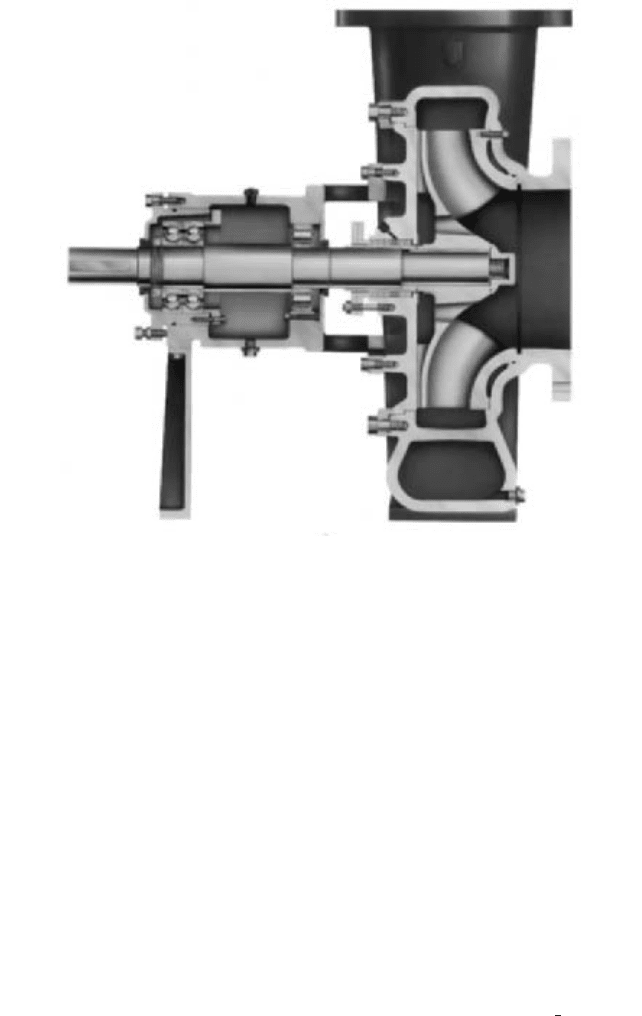
9.8 PULP AND PAPER MILLS 9.167
FIGURE 3 End suction stock pump. (Courtesy ITT / Goulds Pumps, Inc.)
Freeness is often measured by an instrument called the Canadian standard freeness
tester. The range of values covers a scale from 0 to 900, with a higher freeness value indi-
cating a less refined stock and thus a lesser affinity for water. This instrument measures
the amount of water drained from a sample of stock under a regularly decreasing head. Its
use is recommended by the Technical Association of the Pulp and Paper Industry (TAPPI),
and it is commonly employed in North American mills.
STOCK PUMPS In stock pumps, consistency is not a major problem until a value of about
6% is reached. The essential requirement is to get the stock to the pump impeller, and
every effort should be made to keep the piping as large and straight as possible. A typi-
cal open impeller, end suction stock pump is shown in Figure 3.
Above 6% consistency, special pumps are required, and they can be of the positive dis-
placement screw type or centrifugal type. Air entrainment in the stock will reduce pump
output. Air entrainment occurs from agitation in the chests, from flow over weirs, and from
flow through restricted openings. How air entrained in water and in stock affects pump
performance is shown in Figure 6.
PIPING ARRANGEMENT Piping should be as straight and short as possible. This is particu-
larly important on the suction side of the pump to prevent dewatering of the stock. The
diameter of the suction piping should be at least one pipe size larger than the diameter
of the pump suction and should project into the stock chest. The inlet end of the suction
pipe should be cut at an angle, and the bottom of the pipe should be at least 1 pipe diam-
eters from the bottom of the chest. With the long side of the pipe on top, the probability
1
2
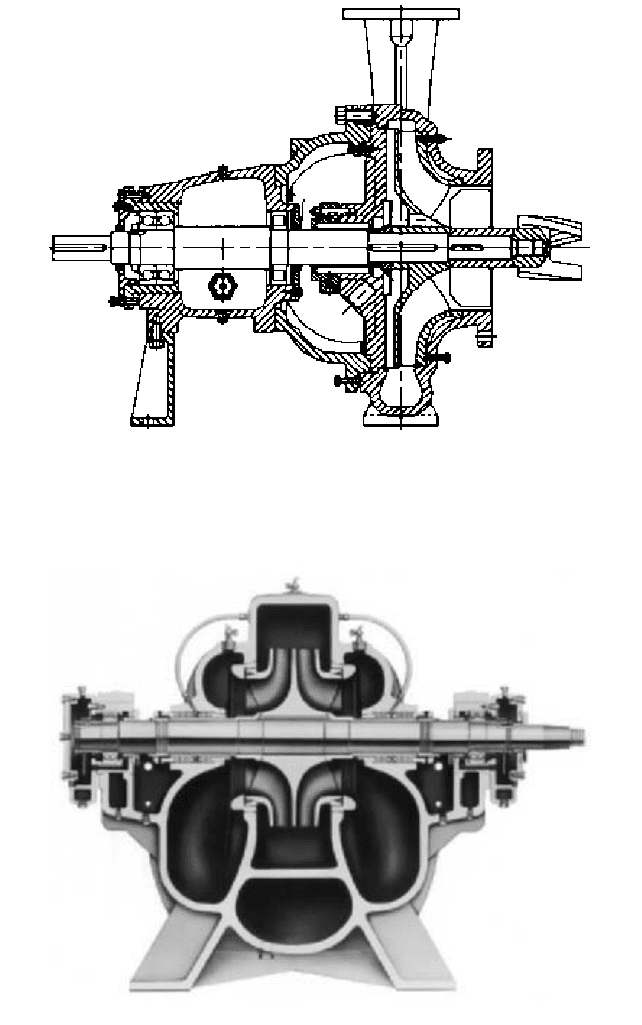
9.168 CHAPTER NINE
FIGURE 4 Medium consistency stock pump. (Courtesy ITT / Goulds Pumps, Inc.)
FIGURE 5 Fan pump. (Courtesy ITT / Goulds Pumps, Inc.)
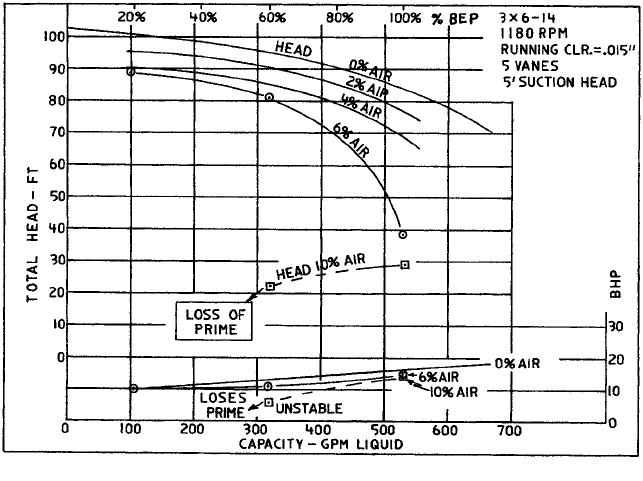
9.8 PULP AND PAPER MILLS 9.169
FIGURE 6 General effect of entrained gas on pump performance. (Courtesy ITT / Goulds Pumps, Inc.)
*Courtesy ITT/Goulds Pumps, Inc.
of drawing air into the suction of the pump through vortices is reduced. Some manufac-
turers provide a lump breaker or screw feeder at the suction side of the pump for pump-
ing stock above from 6% to 8% consistency.
SIZE OF PUMPS It is important to estimate the performance requirements of stock pumps
as accurately as possible. Oversizing of centrifugal pumps will cause an unbalanced radial
thrust on the impeller resulting in excessive shaft deflection and reduced bearing and seal
life. Oversizing can also result in impeller recirculation and the accompanying cavitation-
like noise and damage to pump components.
FRICTION LOSS OF PULP SUSPENSIONS IN PIPE* ________________________
In any stock piping system, the pump provides flow and develops hydraulic pressure
(head) to overcome the differential in head between two points. This total head differen-
tial consists of pressure head, static head, velocity head and total friction head produced
by friction between the pulp suspension and the pipe, bends, and fittings. The total fric-
tion head is the most difficult to determine because of the complex, nonlinear nature of
the friction loss curve. This curve can be affected by many factors.
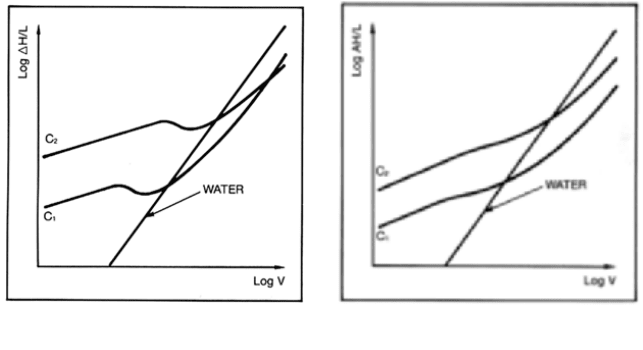
9.170 CHAPTER NINE
FIGURE 7 Friction loss curves for chemical pulp
(C
2
C
1
). (Courtesy ITT / Goulds Pumps, Inc.)
FIGURE 8 Friction loss curves for mechanical pulp
(C
2
C
1
). (Courtesy ITT / Goulds Pumps, Inc.)
The following analytical method for determining pipe friction loss is based on the recently
published TAPPI Technical Information Sheet (TIS) 408-4 (Reference 1), and is applicable to
stock consistencies (oven-dried) from 2 to 6 percent. Normally, stock consistencies of less than
2% (oven-dried) are considered to have the same friction loss characteristic as water.
The friction loss of pulp suspensions in pipe, as presented here, is intended to super-
sede the various methods previously issued.
Figure 7 and Figure 8 show typical friction loss curves for two different consistencies
(C
2
C
1
) of chemical pulp and mechanical pulp, respectively.
The friction loss curve for chemical pulp can be conveniently divided into three regions,
as illustrated by the shaded areas of Figure 9.
These regions may be described as follows:
Region 1 (Curve AB) is a linear region where friction loss for a given pulp is a
function of consistency, velocity, and pipe diameter. The velocity of the upper limit of
this linear region (Point B) is designed V
max
.
Region 2 (Curve BCD) shows an initial decrease in friction loss (to Point C) after
which the friction loss again increases. The intersection of the pulp friction loss curve
and the water friction loss curve (Point D) is termed the onset of drag reduction. The
velocity at this point is designated V
W
.
Region 3 (Curve DE) shows the friction loss curve for pulp fiber suspensions below
the water curve. This is due to a phenomenon called drag reduction. Reference 2
describes the mechanisms which occur in this region.
Regions 2 and 3 are separated by the friction loss curve for water, which is a straight
line with a slope approximately equal to 2.
The friction loss curve for mechanical pulp, as illustrated in Figure 10, is divided into
only two regions:
Regions 1 and 3. For this pulp type, the friction loss curve crosses the water curve at
V
W
and there is no true V
max
.
To determine the pipe friction loss component for a specified design basis (usually daily
mass flow rate), the following parameters must be defined:
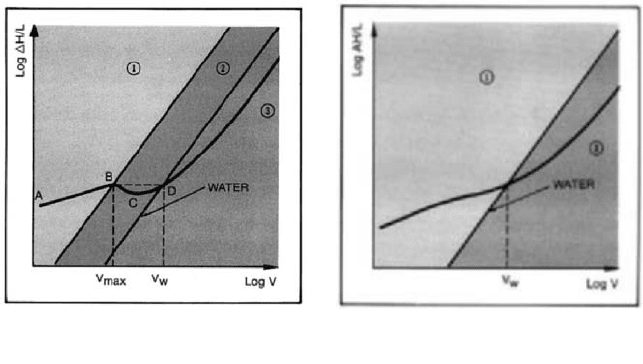
9.8 PULP AND PAPER MILLS 9.171
FIGURE 9 Friction loss curves for chemical pulp,
shaded to show individual regions. (Courtesy ITT /
Goulds Pumps, Inc.)
FIGURE 10 Friction loss curves for mechanical pulp,
shaded to show individual regions. (Courtesy ITT /
Goulds Pumps, Inc.)
a) Pulp Type Chemical or mechanical pulp, long or short fibered, never dried or dried
and reslurried, etc. This is required to choose the proper coefficients which define the
pulp friction curve.
b) Consistency, C (oven-dried) Often a design constraint in an existing system. Note:
If air-dried consistency is known, multiply by 0.9 to convert to oven-dried consistency.
c) Internal pipe diameter, D Lowering D reduces initial capital investment, but
increases pump operating costs. Once the pipe diameter is selected, it fixes the veloc-
ity for a prespecified mass flow rate.
d) Bulk velocity, V Usually based on a prespecified daily mass flow rate. Note that
both V and D are interdependent for a constant mass flow rate.
e) Stock temperature, T Required to adjust for the effect of changes in viscosity of
water (the suspending medium) on pipe friction loss
f) Freeness Used to indicate the degree of refining or to define the pulp for compari-
son purposes
g) Pipe material Important to specify design correlations and compare design values
The bulk velocity (V) will depend on the daily mass flow rate and the pipe diameter (D)
selected. The final value of V can be optimized to give the lowest capital investment and
operating cost with due consideration of future demands or possible system expansion.
The bulk velocity will fall into one of the regions previously discussed. Once it has been
determined in which region the design velocity will occur, the appropriate correlations for
determining pipe friction loss value(s) may be selected. The following describes the proce-
dure to be used for estimating pipe friction loss in each of the regions.
Region 1 The upper limit of Region 1 in Figure 9 (Point B) is designated V
max
. The
value of V
max
is determined using Eq. 1 and data given in Table I or IA.
(1)
where K¿ numerical coefficient (constant for a given pulp is attained from Table
I or IA)
C consistency (oven-dried, expressed as a percentage, not decimally)
s exponent (constant for a given pulp), obtained from Table I or IA
V
max
K¿C
s
1ft>s2,
9.172 CHAPTER NINE
If the proposed design velocity (V) is less than V
max
, the value of flow resistance (H/L)
may be calculated using Eq. 2 and data given in Table II or IIA, and the appendices.
(2)
where F factor to correct for temperature, pipe roughness, pulp type, freeness, or
safety factor (refer to Appendix D)
K numerical coefficient (constant for a given pulp), obtained from Table II or IIA
V bulk velocity (ft/s)
C consistency (ven-dried, expressed as a percentage, not decimally)
D pipe inside diameter (in)
a, b, y exponents (constant for a given pulp), obtained from Table II or IIA
For mechanical pumps, there is no true V
max
. The upper limit of the correlation equa-
tion (Eq. 2) is also given by Eq. 1. In this case, the upper velocity is actually V
W
.
Region 2 The lower limit of Region 2 in Figure 9 (Point B) is V
max
and the upper limit
(Point D) is V
W
. The velocity of the stock at the onset of drag reduction is determined
using Eq. 3.
(3)
where C consistency (oven-dried, expressed as a percentage, not decimally).
If V is between V
max
and V
W
, Eq. 2 may be used to determine H/L at the maximum
point (V
max
). Because the system must cope with the worst flow condition, H/L at the
maximum point (V
max
) can be used for all design velocities between V
max
and V
W
.
Region 3 A conservative estimate of friction loss is obtained by using the water curve.
(H/L)
W
can be obtained from a Friction Factor vs. Reynolds Number plot (for
example, Hydraulic Institute ANSI/HI 2000 Edition Pump Standards, Reference 3),
or approximated from the following equation (based on the Blasius equation.)
(4)
where V bulk velocity (ft/s)
D pipe diameter (in)
Previously published methods for calculating pipe friction loss of pulp suspensions
gave a very conservative estimate of head loss. The method just described gives a more
accurate estimate of head loss due to friction, and has been used successfully in systems
in North America and world-wide.
Please refer to Appendix A for equivalent equations for use with metric (SI) units.
Tables I and IA are located in Appendix B; Tables II and IIA are located in Appendix C.
Pertinent equations, in addition to those herein presented, are located in Appendix D.
Example problems are located in Appendix E.
The friction head loss of pulp suspensions in bands and fittings may be determined
from the basic equation for head loss, Eq. 5.
(5)
where K loss coefficient for a given fitting
V
1
inlet velocity (ft/s)
g acceleration due to gravity (32.2 ft/s
2
)
Values of K for the flow of water through various types of bends and fittings are tabu-
lated in numerous reference sources (for example, Hydraulic Institute ANSI/HI 2000 Edi-
tion Pump Standards, Reference 3). The loss coefficient for valves may be obtained from
the valve manufacturer.
H KV
1
2
>2g 1ft2
1¢H>L2
W
0.58V
1.75
D
1.25
1f>100 ft2
V
W
4.00C
1.40
1ft>s2
H>L FKV
a
C
b
D
y
1ft>100 ft2
9.8 PULP AND PAPER MILLS 9.173
The loss coefficient for pulp suspensions in a given bend or fitting generally exceeds the
loss coefficient for water in the same bend or fitting. As an approximate rule, the loss coef-
ficient (K) increases 20 percent for each 1 percent increase in oven-dried stock consistency.
Please note that this is an approximation; actual values of K may differ, depending on the
type of bend or fitting under consideration (4).
Appendix A When metric (S/I) units are utilized, the following replace the correspond-
ing equations in the main text.
(1M)
where K numerical coefficient (constant for a given pulp), obtained from table I or IA
C consistency (oven-dried, expressed as a percentage, not decimally)
s exponent (constant for a given pulp), obtained from Table I or IA
(2M)
where F factor to correct for temperature, pipe roughness, pulp type, freeness, or
safety factor (refer to Appendix D)
K numerical coefficient (constant for a given pulp), obtained from Table II or IIA
V bulk velocity (m/s)
C consistency (oven-dried, expressed as a percentage, not decimally)
D pipe inside diameter (mm)
a, b, y exponents (constant for a given pulp), obtained from Table II or IIA
(3M)
where C consistency (oven-dried, expressed as a percentage, not decimally).
(4M)
where V bulk velocity (m/s)
D pipe inside diameter (mm)
(5M)
where K loss coefficient for a given fitting
V
1
inlet velocity (m/s)
g acceleration due to gravity (9.81 m/s
2
)
H KV
1
2
>2 g 1m2
1¢H>L2
w
264V
1.75
D
1.25
1m>100m2
V
W
1.22C
1.40
1m>s2
¢H>L FKV
a
C
b
D
y
1m>100 m2
V
max
K¿C
s
1m>s2

9.174 CHAPTER NINE
TABLE IA Data (5, 6) for use with Eq. 1 or Eq. 1M to determine velocity limit, V
max
Pulp Type
(5)
Pipe Material K¿ s
Unbleached sulphite Copper 0.98 (0.3) 1.2
Bleached sulphite Copper 0.98 (0.3) 1.2
Kraft Copper 0.98 (0.3) 1.2
Bleached straw Copper 0.98 (0.3) 1.2
Unbleached straw Copper 0.98 (0.3) 1.2
Estimates for othe pulps based on published literature.
Pulp Type
(5, 6)
Pipe Material K¿ s
Cooked groundwood Copper 0.75 (0.23) 1.8
Soda Steel 4.0 (1.22) 1.4
Note: When metric (SI) units are utilized, use the value of K¿ given in parentheses. When the
metric values are used, diameter (D) must be in millimeters (mm) and velocity (V) in meters per
second (m/s).
TABLE I Data for use with Eq. 1 or Eq. 1M to determine velocity limit, V
max
(1)
Pulp Type Pipe Material K¿ s
Unbeaten aspen sulfite never dried Stainless Steel 0.85 (0.26) 1.6
Long fibered kraft never dried CSF 725
(6)
PVC 0.98 (0.3) 1.85
Stainless Steel 0.89 (0.27) 1.5
Long fibered kraft never dried CSF 650
(6)
PVC 0.85 (0.26) 1.9
Long fibered kraft never dried CSF 550
(6)
PVC 0.75 (0.23) 1.65
Long fibered kraft never dried CSF 260
(6)
PVC 0.75 (0.23) 1.8
Bleached kraft never dried and reslurried
(6)
PVC 0.79 (0.24) 1.5
Stainless Steel 0.59 (0.18) 1.45
Long fibered kraft never dried and reslurried
(6)
PVC 0.49 (0.15) 1.8
Kraft birch dried and reslurried
(6(
PVC 0.69 (0.21) 1.3
Stone groundwood CSF 114 PVC 4.0 (1.22) 1.40
Refiner groundwood CSF 150 PVC 4.0 (1.22) 1.40
Newsprint broke CSF 75 PVC 4.0 (1.22) 1.40
Refiner groundwood (hardboard) PVC 4.0 (1.22) 1.40
Refiner groundwood (insulating board) PVC 4.0 (1.22) 1.40
Hardwood NSSC CSF 620 PVC 0.59 (0.18) 1.8
Notes:
1. When metric (SI) units are utilized, use the value of K¿ given in parentheses. When the met-
ric values are used, diameter (D) must be in millimeters (mm) and velocity (V) in meters per
second (m/s).
2. Original data obtained in stainless steel and PVC pipe. PVC is taken to be hydraulically
smooth pipe.
3. Stainless steel may be hydraulically smooth although some manufacturing processes may
destroy the surface and hydraulic smoothness is lost.
4. For cast iron and galvanized pipe, the K¿ values will be reduced. No systematic data are avail-
able for the effects of surface roughness.
5. If pulps are not identical to those shown, some engineering judgment is required.
6. Wood is New Zealand Kraft pulp.
Appendix B

TABLE II Data for use with Eq. 2 or Eq. 2M to determine head loss, H/L
(1)
Pulp Type K ab y
Unbeaten aspen sulfite never dried 5.30 (235) 0.36 2.14 1.04
Long fibered kraft never dried CSF 725
(5)
11.80 (1301) 0.31 1.81 1.34
Long fibered kraft never dried CSF 650
(5)
11.30 (1246) 0.31 1.81 1.34
Long fibered kraft never dried CSF 550
(5)
12.10 (1334) 0.31 1.81 1.34
Long fibered kraft never dried CSF 260
(5)
17.00 (1874) 0.31 1.81 1.34
Bleached kraft bleached and reslurried
(5)
8.80 (970) 0.31 1.81 1.34
Long fibered kraft dried and reslurried
(5)
9.40 (1036) 0.31 1.81 1.34
Kraft birch dried and reslurred
(5)
5.20 (236) 0.27 1.78 1.08
Stone groundwood CSF 114 3.81 (82) 0.27 2.37 0.85
Refiner groundwood CSF 150 3.40 (143) 0.18 2.34 1.09
Newspaper broke CSF 75 5.19 (113) 0.36 1.91 0.82
Refiner groundwood CSF (hardboard) 2.30 (196) 0.23 2.21 1.29
Refiner groundwood CSF (insulating board) 1.40 (87) 0.32 2.19 1.16
Hardwood NSSF CSF 620 4.56 (369) 0.43 2.31 1.20
Notes:
1. When metric (SI) units are utilized, use the value of K¿ given in parentheses. When the met-
ric values are used, diameter (D) must be in millimeters (mm) and velocity (V) in meters per
second (m/s).
2. Original data obtained in stainless steel and PVC pipe (7, 8, 9).
3. No safety factors are included in the above correlations.
4. The friction loss depends considerably on the condition of the inside of the pipe surface (10).
5. Wood is New Zealand Kraft pulp.
TABLE IIA Data
(5, 6)
for use with Eq. 2 or Eq. 2M to determine head loss, H/L
Pulp Type
(5)
K ab y
Unbleached sulfite 12.69 (1438) 0.36 1.89 1.33
Bleached sulfite 11.40 (1291) 0.36 1.89 1.33
Kraft 11.40 (1291) 0.36 1.89 1.33
Bleached straw 11.40 (1291) 0.36 1.89 1.33
Unbleached straw 5.70 (646) 0.36 1.89 1.33
Estimates for other pulps based on published literature.
Pulp Type
(5, 6)
K ab y
Cooked groundwood 6.20 (501) 0.43 2.13 1.20
Soda 6.50 (288) 0.36 1.85 1.04
Note: When metric (SI) units are utilized, use the value of K¿ given in parentheses. When the
metric values are used, diameter (D) must be in millimeters (mm) and velocity (V) in meters per
second (m/s).
9.8 PULP AND PAPER MILLS 9.175
Appendix C
Appendix D
The following gives supplemental information to that where I.P.D. mill capacity (metric
tons per day), provided in the main text.
